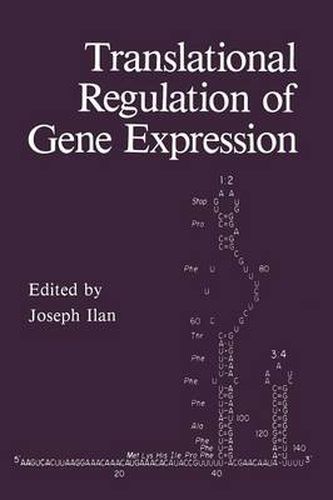Readings Newsletter
Become a Readings Member to make your shopping experience even easier.
Sign in or sign up for free!
You’re not far away from qualifying for FREE standard shipping within Australia
You’ve qualified for FREE standard shipping within Australia
The cart is loading…






This title is printed to order. This book may have been self-published. If so, we cannot guarantee the quality of the content. In the main most books will have gone through the editing process however some may not. We therefore suggest that you be aware of this before ordering this book. If in doubt check either the author or publisher’s details as we are unable to accept any returns unless they are faulty. Please contact us if you have any questions.
Given the accelerated growth of knowledge in the field of gene expression, it seemed timely to discuss current developments in the area of translational reg- ulation of gene expression as well as to evaluate emerging technology. Translational regulation occurs with prokaryotic as well as with eukaryotic messenger RNA (mRNA) in vivo and in vitro. In prokaryotes, through genetic manipulations and mutagenesis, the mechanisms are much better understood, as for example the mechanism of attenuation. In bacteria, different translational efficiencies for the same mRNA may vary by lOOO-fold. Translational regulation was first observed in 1966 with RNA phages of Escherichia coli by Lodish and Zinder. However, translational regulation of proteins from DNA genomes is also well described for bacteria, as for example gene 32 protein of bacteriophage T4 and E. coli ribosomal proteins. In eukaryotes, the utilization of an individual mRNA species with different efficiencies is poorly understood. For example, mRNA for ribosomal proteins is translationally regulated during Drosophila oogenesis, without any clue to the mechanism involved. It was observed that ribosomal protein mRNA during Drosophila oogenesis and embryogenesis is selectively on or off the polysomes during different developmental stages. In contrast, bacterial ribosomal protein is also translationally regulated by autogenous regulation. The mechanism is well understood and involves binding of the gene product to its transcript in competition with rRNA.
$9.00 standard shipping within Australia
FREE standard shipping within Australia for orders over $100.00
Express & International shipping calculated at checkout
This title is printed to order. This book may have been self-published. If so, we cannot guarantee the quality of the content. In the main most books will have gone through the editing process however some may not. We therefore suggest that you be aware of this before ordering this book. If in doubt check either the author or publisher’s details as we are unable to accept any returns unless they are faulty. Please contact us if you have any questions.
Given the accelerated growth of knowledge in the field of gene expression, it seemed timely to discuss current developments in the area of translational reg- ulation of gene expression as well as to evaluate emerging technology. Translational regulation occurs with prokaryotic as well as with eukaryotic messenger RNA (mRNA) in vivo and in vitro. In prokaryotes, through genetic manipulations and mutagenesis, the mechanisms are much better understood, as for example the mechanism of attenuation. In bacteria, different translational efficiencies for the same mRNA may vary by lOOO-fold. Translational regulation was first observed in 1966 with RNA phages of Escherichia coli by Lodish and Zinder. However, translational regulation of proteins from DNA genomes is also well described for bacteria, as for example gene 32 protein of bacteriophage T4 and E. coli ribosomal proteins. In eukaryotes, the utilization of an individual mRNA species with different efficiencies is poorly understood. For example, mRNA for ribosomal proteins is translationally regulated during Drosophila oogenesis, without any clue to the mechanism involved. It was observed that ribosomal protein mRNA during Drosophila oogenesis and embryogenesis is selectively on or off the polysomes during different developmental stages. In contrast, bacterial ribosomal protein is also translationally regulated by autogenous regulation. The mechanism is well understood and involves binding of the gene product to its transcript in competition with rRNA.